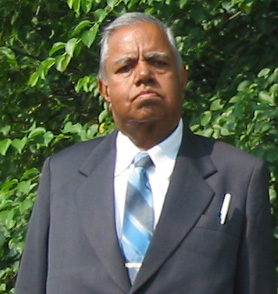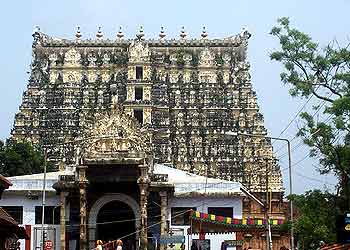Contribute
| The Priceless Treasures Of Shree Padmanabha Temple |
Dr. R. Subrahmonia Ayyar
07/07/2011
The Padmanabha temple located in the city of Thiruananthapuram capital of Kerala state (erstwhile Travancore state) came to lime light in all global media when treasures worth billions of dollars tumbled forth from the 6 concealed cellars in the temple premises during a recent inventory conducted by a 6 member committee under the orders of the Supreme Court of India. The treasures consists of meticulously crafted gold and silver vessels studded with precious stones for the various rituals of the temple, sackfuls of gold coins dating back to the time of East India Company and even Napoleon, several anklets and trinkets of gold studded with precious stones, a unique 18 feet long golden chain, several gold sarapalli necklaces, golden crown and a golden mask (anki) in parts to perfectly fit and cover the entire body of the idol from head to foot. One interesting find is a couple of exquisitely duplicated golden coconut shells studded with precious gems in which offering of pickled raw mangoes is made daily over centuries.
The uncovering of these treasures has raised several questions as to when and by whom they were donated, why most of them were concealed in cellars, to whom do they belong now and what is to be done with them. To get the answers to these questions one has to trace the history of the temple over several centuries since its conception which again is closely linked to the history of the Travancore Royal Dynasty.
Although a small wooden shrine seems to have existed from about 1000 years back, construction of the temple in its present form was started in the beginning of the 18th century by Anisham Thirunal Marthandaverma, the founder of the Travancore State. The kings of the dynasty are known by the stars under which they are born, followed by 2 names Marthandaverma and Ramaverma alternately by successive rulers. Thus Marathadaverma was succeeded by Kathika Thirunal Ramaverma. King Marthandaverma had to overcome several insurmountable obstacles including many years in exile, several bloody battles in which he had to kill many of the kith and kin in family feuds before his ascendancy to the throne. After he became the king, he quelled several rebellions and annexed several small states to create the expanded Travancore state which became part of the Indian union after India’s Independence in 1947. To win over the loyalty of the masses most of whom were Hindus, he adopted the strategic move of dedicating the state to Lord Padmanabha and proclaiming that he will rule the state as a vassal of the Lord. He also constituted an advisory council consisting of eight powerful Namboodhiri Brahmin Mutts including him as an associate member (ettarayogam).
When the old shrine including the idol was burnt down by an accidental fire, he started the construction of the New Temple in granite. 1008 saligrams (rounded pebbles) were brought from the Kantaki River in Nepal by 36 elephants. The sculptors mixed those with a special mortar and moulded the 18 feet long idol of Padmanabha in the lying posture which is the one being worshipped today. The unique feature of this idol is that it is lying with the face of God looking upwards the ceiling and His extended right hand doing pooja to a Shiva Linga. The entire idol cannot be seen through one entrance. Devotees can see the head through the left entrance, the trunk through the middle and the feet through the right. The name Padmanabha means God with a lotus sprung from the belly button and this can be seen on the idol. Another unique feature is a 25 feet by 25 feet prayer mandap made of a single stone (ottakal mandap) in front of the Sanctum sanctorum. Even today it is a wonder how a huge rock was hauled into this position to carve out this mandap. It is a unique feature that there are no separate shrines in the temple for any Goddess, the three main deities being Padmanabha, Narasimha and Krishna.
Narasimha and Padmanabha are enshrined in the main granite temple while Krishna is enshrined in an adjoining wooden temple. There seems to have a later extension in brick work. There are 4 entrances to the temple, east, west, north and south. The main entrance is the eastern one with a seven tier tower (gopuram) over it with seven gilded kalasams on the top.
To atone for the sins committed by killing large number of people in the battles, King Marthandaverma was advised by his council to start daily feeding of Brahmins throughout the year. This tradition continued till the state got annexed to the Indian union. To inculcate the growth of bhakthi among the masses for the Lord, the king started several religious rituals in the temple. Some of the rituals are really grand and colorful and are continued even today. The outstanding one among them is Lakshadeepam (festival of lakh of lights) celebrated every 6 years. On that day a lakh of oil lamps are lit in the temple premises as a symbol of prayer for the salvation of departed souls. It is preceded by 56 days of Vedic chanting and offerings in the sacrificial fire by learned pundits.
Another remarkable event is a ten-day festival culminating in Aaraattu celebrated twice a year. On the day of Aaraattu, the three bedecked idols of the three deities Padmanabha, Narasimha and Krishna are carried in a grand procession from the temple to the sea beach which is a mile away. The King leads the procession walking barefooted in front of the deities wearing a dhoti and holding upright a sword in hand. He is flanked by all the top officials of the state and temple employees accompanied by caparisoned elephants. Army men stand in attention on either side of the procession. Musical encore is provided by the police band and nadaswaram, a grand gala procession watched by thousands. After the deities are given a divine bath in the sea, the procession returns with the same grandeur. There are also other festivals like the navarathri when music concerts by renowned musicians are arranged.
Now the question arises as to where the treasures came from. King Marthandaverma made Lord Padmanabha the ruler of the state. It was decided by his council that the excess revenue accruing at the end of each year after meeting the expense of the state and the temple should be converted into precious valuables and gifted to be stored in the temple coffers. It was also rumored at that time that these treasures could be used at times of famine and the unlikely event of intrusion or invasion by the Britishers. A massive treasure trove grew over the centuries. This tradition seems to have been discontinued at some point of time when the state did not have revenue surplus. This had its impact on the temple rituals also which got reduced, due to paucity of funds. Who is the owner of the treasures? Obviously Lord Padmanabha to whom it was donated. It is God alone who will decide how to preserve them safely and securely for the benefit of posterity.
Most of the information given in this article is authentic as told to us by my father-in-law, Shri T.R. Krishna Iyer. He was a dedicated devotee of Lord Padmanabha and a trusted servant of the King. He had the privilege of serving the temple as the Executive Officer for a decade. Impeccably honest and straightforward, he used to meticulously organize and conduct not only the daily rituals but also the festivals including to Laskhadeepams.
Comments and additional information, if any, may please be given by the readers for which I shall be grateful.
You may also access this article through our web-site http://www.lokvani.com/

